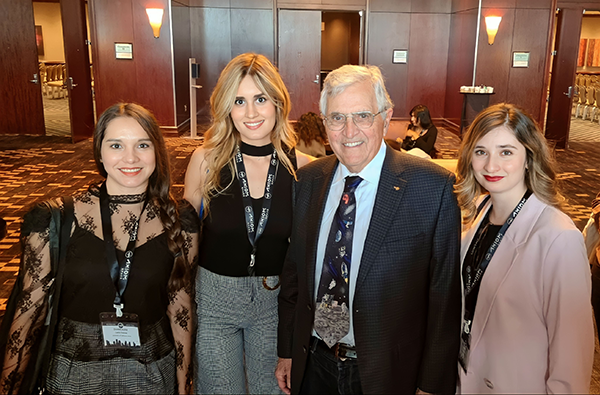Graduate Students Meet Astronaut Harrison Schmitt at National Conference

April 6, 2023 - Three UCI Samueli School of Engineering graduate students met astronaut and geologist Harrison Schmitt, the first scientist and last person to step on the moon, at the American Society for Gravitational and Space Research (ASGSR) 2022 conference. The three doctoral students – Dianalaura Cueto Duenas and Margarita Rivera in civil and environmental engineering and Daniela Ruiz in mechanical and aerospace engineering – each received a $1,000 travel stipend to attend the four-day gathering in Houston last November where they attended a panel with the astronaut.
ASGSR partners with NASA to offer stipends to students and faculty from Minority Serving Institutions who have never attended the annual conference to expand the network. Recipients are selected based on several factors including merit and geographical diversity. UCI project scientist Yu-Chien (Alice) Chien, who was aware of the opportunity through her work as principal investigator for a NASA project, recommended the three students apply.
“The conference itself spans many research areas so it’s great for them to see everything rather than go to one conference that focuses only on their specific areas,” said Chien.
While the conference centers on gravitational research, the 2022 presenters explored diverse fields including biology and physical sciences in relation to space technology.
Schmitt served as Lunar Module Pilot on the Apollo 17 mission in 1972 and collected geological samples and data in the Taurus-Littrow lunar valley. At the talk the graduate students attended, he discussed the importance of sending scientists to space to collect their own data instead of receiving samples from astronauts after the missions.
“If someone else is collecting your samples, something might not be done how it should,” explained Ruiz. “That could affect the results of your experiments.”
Schmitt advocated training scientists for space missions and spoke about his own preparation. He was especially challenged by the physical training astronauts must endure to condition the body for zero gravity.
The students explored a variety of fields related to space and gravity represented at the conference and how their individual research can be applied to space missions.
“It was really interesting to see the latest technology in fire safety for space travel,” said Rivera, whose research uses remote sensing observation to track wildfire spread. “It broadened my perspective on fire research options.”
They also valued networking in person since the conferences they had previously attended were held online. Their highlights included learning about internships, talking with researchers about the challenges of replicating microgravity conditions and meeting CEOs of companies that are pursuing commercial space travel.
“I saw a lot of research that focused on areas I’d never thought about,” said Cueto Duenas. “Now, I have it all in the back of my mind.”
– Lilith Christopher
